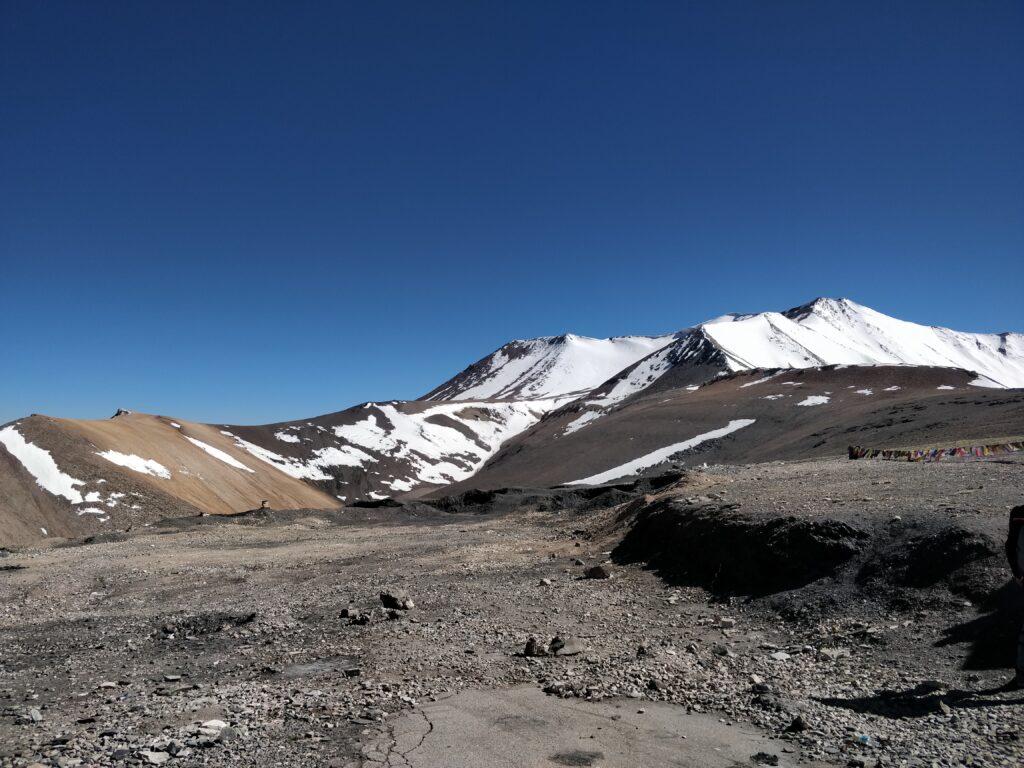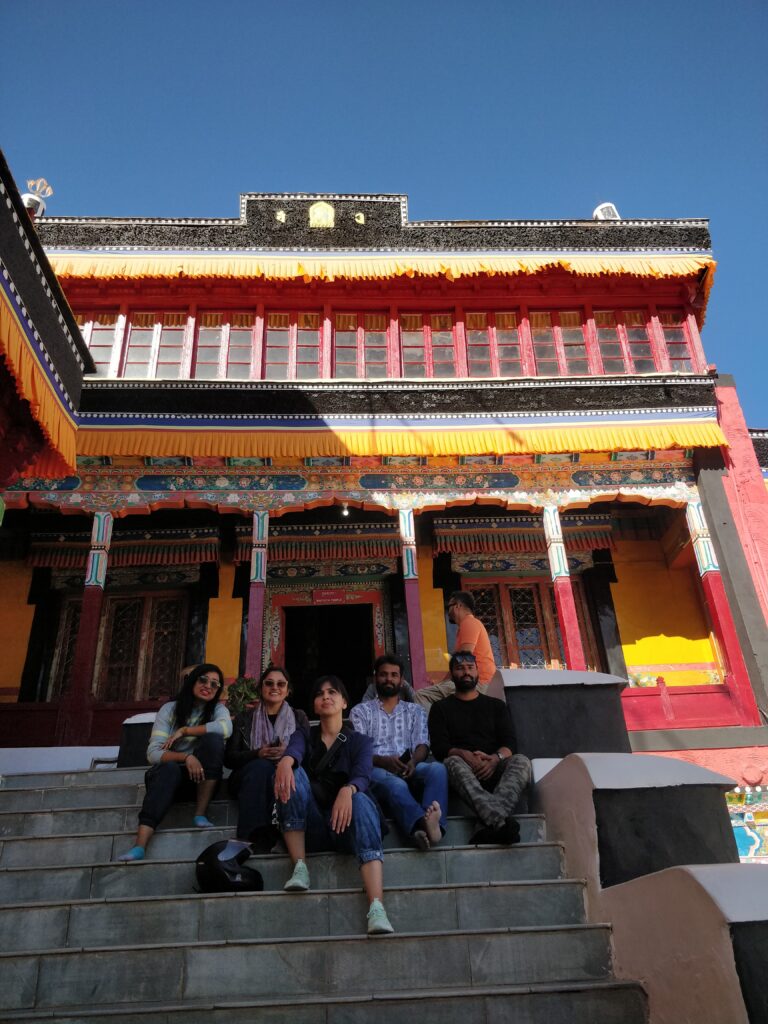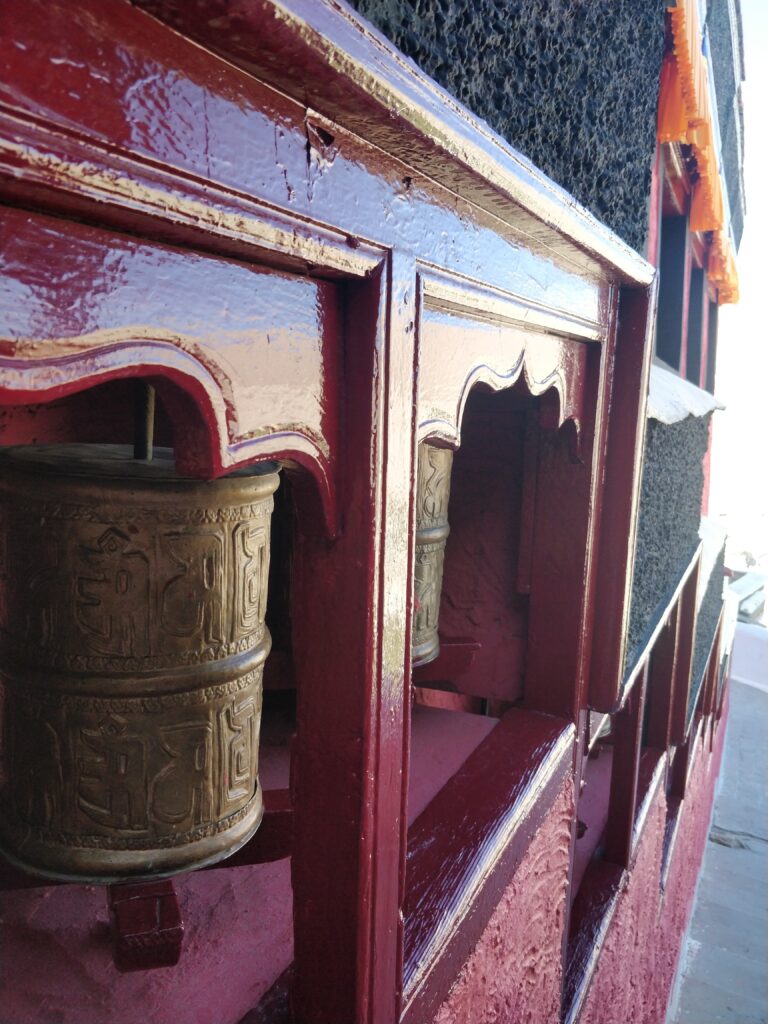Leh, the capital of Ladakh, was once a major stop along the historic Silk Road. With an area of 45,110 square kilometres, it is also the country’s second largest district.
Its elegant balconies, ornate carvings, and regal interiors offer a glimpse into the opulent lifestyle of the Ladakhi royal family which serves as a museum, showcasing an impressive collection of royal artifacts, jewellery, and traditional Ladakhi dresses.
With its stunning panoramic views of the snow-capped Himalayan peaks and the bustling city below, the town is located towards the eastern side of Jammu and Kashmir, at an altitude of 3505 meters above sea level. The area is watered by the Zanskar River which flows into the Indus River. There are two routes to Leh- one from Manali in the south and another from Srinagar in the west. The Leh Palace is truly a marvel that transports visitors back in time and enchants them with its timeless allure.
There are flights to Leh from Delhi, Srinagar, and Jammu on a regular basis. During the first few months of the year, when the snow gets melted, the roads to the town are open. For those interested in biking tours, they can use the Manali-Leh Highway and Srinagar-Leh Highway from around June to October. One can also use bus, taxi, and jeep services from here.
In Leh, tourists may experience a wide range of vibrant events that pay homage to historical traditions and customs. The Hemis Festival is a huge event that commemorates the birthday of Guru Padmasambhava, the spiritual leader who introduced Tibetan Buddhism to the world. Music, dancing, and vibrant costumes fill the Hemis Monastery during the festival as local monks conduct masked dances that celebrate the victory of virtue over evil. The Ladakh Festival, held in September, is another well-attended event that celebrates the region’s unique culture via song, dance, and the use of traditional garb. Sports like polo and archery are significant parts of Ladakhi culture and may be seen by tourists.

offbeat compass
PLACES IN AND AROUND LEH:
Leh Palace:
Built-in the 17th century by King Sengge Namgyal, this towering nine-story palace boasts an awe-inspiring architecture that mirrors the rich cultural heritage and history of Ladakh. With its impressive nine stories and unique blend of Tibetan, Indian, and European architectural styles, the palace is a striking sight to behold.
Shanti stupa:
The stupa is a popular destination for its intricate engravings, which depict scenes from the life of Buddha and other important events in Buddhist history. These engravings, along with the vibrant colors and entangled patterns that adorn the stupa’s surface, are a true testament to the skill and craftsmanship of the artists who created it. Additionally, the stupa is illuminated at night, casting a serene and peaceful glow over the town of Leh and providing a unique and unforgettable viewing experience for visitors.
Leh Old Town:
The uniqueness of Leh Old Town lies in its ability to transport visitors back in time to a bygone era of Ladakhi culture and history. With its narrow winding streets, ornate traditional architecture, and bustling markets selling everything from handicrafts to street food, the old town is a veritable feast for the senses. As you wander through its authentic alleys, you’ll discover hidden gems at every turn, from centuries-old monasteries to ancient palaces and temples. But perhaps the most captivating aspect of Leh Old Town is its people, who are friendly, welcoming, and deeply proud of their heritage.
Spituk Gompa:
The Spituk Gompa, located on a hilltop near Leh, is a unique and fascinating destination that captures the spirit of Ladakh’s rich Buddhist heritage. What sets it apart from other monasteries in the region is its stunning location, perched high above the Indus River with sweeping views of the surrounding mountains. But perhaps the most unique aspect of the Spituk Gompa is its rich collection of artifacts and religious relics, including ancient masks, thangka paintings, and sculptures.
Tsemo Fort:
Tsemo Fort, on the other hand, is an ancient fortress that has stood the test of time for over 400 years. Located on a hilltop overlooking the town of Leh, the fort offers breathtaking views of the surrounding landscape, as well as a fascinating glimpse into Ladakh’s military history.
Central Asian Museum:
Housed in a beautiful traditional Ladakhi building, the museum is a treasure trove of artifacts, manuscripts, and artwork from Central Asia, including Ladakh, Tibet, and the Silk Route. The museum also features a range of interactive exhibits, including traditional games, musical instruments, and a replica of a traditional Ladakhi kitchen.
SHOPPERS AREA AND TASTING ARENA:
The Main Bazaar is a popular bazaar in Leh where tourists may buy everything from local handicrafts and souvenirs to authentic Tibetan apparel and souvenirs. Norbu Linga, the Tibetan refugee bazaar, and the Nowshera market are three other world-famous marketplaces that every shopper should see at least once throughout their lives.
Ladakhi Thukpa, a substantial noodle soup loaded with veggies, meat, and aromatic spices, is a local favorite in Leh. Locally grown apricots in Leh are used to manufacture a number of tasty treats, such as the region’s signature Apricot Jam and the more modern Apricot tart. Butter tea, a local specialty, combines tea leaves, Yak butter, and salt to create a salty and creamy beverage.
Offbeat Compass focuses on responsible and sustainable tourism, giving travelers a chance to connect with local communities, experience unique cultures, and explore breathtaking landscapes. With a commitment to promoting ethical and eco-friendly tourism practices. Travel with Offbeat Compass for an authentic, off-the-beaten-path adventure that leaves a lasting impression.

offbeat compass
FAQS:
1. What is the best time to visit Leh?
The best time to visit Leh is during the summer months from May to September when the weather is mild and pleasant. The winter months from November to February are extremely cold and snowy, making travel difficult.
2. Are there any medical facilities in Leh?
Yes, there are medical facilities in Leh, including a government hospital and several private clinics. However, medical facilities can be limited, especially in remote areas, so it’s recommended to carry the necessary medications and consult with a doctor before traveling.
3. Can a person with asthma visit Leh?
People with asthma may go to Leh, although they may need to take special measures because of the high altitude and chilly weather. Asthma sufferers should take their time getting used to the high altitude and refrain from any activities that can set off their condition. With offbeat compass’s assistance, you’ll know about all the safety measures you need to take.
4. What is the weather like in Leh?
Leh experiences a cold desert climate with long and harsh winters and short summers. The summer months are mild and pleasant, with average temperatures ranging from 15°C to 30°C. The winter months are extremely cold, with temperatures dropping below freezing and heavy snowfall.
5. What are some adventurous activities to do in Leh?
Leh offers a range of adventurous activities, including trekking, mountaineering, river rafting, mountain biking, and camping. Visitors can also take a scenic drive along the Leh-Manali Highway or explore the frozen Zanskar River during the winter months.

offbeat compass
